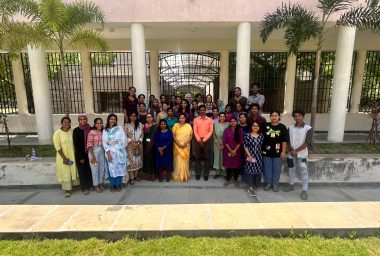-
Authoradmin
-
Comments0 Comments
-
Category
A study on the Abacus learning of Mental Arithmetic and its influence on the Academic Performance of children
Published in : Journal Of Psychological Researches,Volume 57,Number 2,August 2013( ISSN 0022-3972)
K.Vasuki* and P.J.Charumathi**
A study on the Abacus learning of Mental Arithmetic and its influence on the Academic Performance of children
K.Vasuki* and P.J.Charumathi**
The present research made an attempt to study the influence of Abacus learning of Mental Arithmetic on the Academic Performance of children. The research design adopted for the present study was quasi experimental design with pre and post test. Using simple random sampling and purposive sampling, 72 children consisting of both the gender of equal size ranging from 8-12 years are selected for experimental group. Similarly, 72 children were selected for the control group. Children who belonged to experimental group were abacus learners and those belonged to control group were non-abacus learners. Collected data were subjected to statistical analysis like paired `t’ test, unpaired `t’ test. Results indicated that those who underwent abacus learning of mental arithmetic programme were better performed than their peer group in their academic performance.
The concept of mental arithmetic has recently gained immense popularity in India. It is not an alternative to the mainstream curriculum. It is only to make learning a fascinating one for children.In India this programme also comes as a lucrative employment opportunity for women.
The easier the method one use to solve a problem, the faster one will solve it with less chance of making a mistake.(Bill Handley, 2000) The difference between high achievers and low achievers is not the brain they were born with but how they learn to use it. High achievers use better strategies than low achievers. Abacus learning of mental maths will teach better strategies. These methods are easier than those that have been learnt in the conventional method of learning maths. Therefore, those who are learning such methods will solve problems more quickly and make fewer mistakes.
The Abacus is typically constructed using various types of hardwoods and comes in different sizes. The frame of the Abacus has a series of vertical rods on which a number of wooden beads are allowed to slide freely. A horizontal beam separates the frame into two sections, named as the upper deck and the lower deck. Value of each bead in the upper deck is five and value of a bead in the lower deck is one. Each 5 – unit bead had a ‘face value’ of ‘five’ and each 1-unit bead has a ‘face value’ of ‘one’. Beads are considered counted, when moved towards the beam that separates the two decks.The first column from the right extreme is the ‘Ones/Unit’ column; the second one from the right side is the ‘Tens’ column; the next one is the ‘Hundreds’
——————————————————————————————————————————————————————–
* Psychologist, Chennai
** Former Head of the Department, Department of Applied Psychology and Behavioural Research, JBAS College for Women, Chennai
column,and so on. After 5 beads are counted in the lower deck, the result is “carried forward” to the upper deck; after both beads in the upper deck are counted, the result (10) is then carried to the left-most adjacent column. Each column has a place value of 10 times the place value of the column on its right. In summary, columns on the left always have values ten folds higher that the immediate columns on the right.
Abacus is probably the first of calculating devices. Numbers converted as bead/s positions make images that are registered in the brain thus the constant image push impinging on the brain-screen makes it an active receptive zone, which is referred as mind Abacus. Abacus acts as a catalyst in developing few cognitive abilities in Abacus learners. Therefore, Abacus could be regarded as an effective educational tool and Abacus training could be an intervention with exemplary strategies for children. In the present traditional education system more importance is given for maths but less emphasis is given for mental calculation. The children in the world seem to have a tendency of disliking calculation. But the basics of life are made from calculation. Children who dislike calculation may not necessary become the failure of life, but they do tend to have difficulties in life and might lead to a delay in the development of the brain functions relative to calculation. It may fairly be said that an improvement of calculation skills ‘Abacus etc…’ are the basic of human education. As abacus method of teaching enables the child to understand the concepts like,
The concept of Numbers
· The concept of digit place
· The concept of Numbers’ group
· The concept of the four basic arithmetic operations
The Salient features of Abacus education includes:
· instill in children the habit of Careful Observation
· instill in children the habit of good memory and recall of data with maximum efficiency and minimum energy.
· instill in children the habit of using multiple skills simultaneously with maximum efficiency and minimum economy.
· in children the importance of sound reasoning and original thinking.
· expands the child’s mental powers like visualization and creativity and thus to uplift their morale.
Bakan,.P. (1976) has focused on the significance of left/right hemisphere differences for management in the “Creative Brain”. He says for most people, one of the two hemispheres is the dominant one in terms of our preferred mode of processing. Abacus mental arithmetic programmes also apply this method to induce the sub-consciousness in the brain, by the effective training in right brain, and coordinate with the left brained education system in schools to give free rein to the whole brain learning concept. Abacus learning was effective in training the right brain or the analog brain. Due to the development of cerebral physiology and machines that can accurately measure the amount of blood flow in the brain, recent studies have proven that the Abacus method of mental calculation is extremely effective in activating the right brain. However the training at the early stages of life will help to inculcate the habit of using Abacus method.
OBJECTIVES OF THE STUDY
1. To find about the significant effect of Abacus learning on children’s Academic performance
2. To find out if there is any difference between children of experimental and control
group in general Mathematics, Science and English due to Abacus learning.
HYPOTHESES OF THE STUDY
As the reviews of previous research indicate the need for scientific research relating to the effect of Abacus method of learning, the study is an explorative one. Therefore, null hypotheses have been proposed.
The following Hypotheses were framed based to answer the objectives of the present
Investigation:
a) There will be no significant difference in the pre test scores between the children of experimental and control group in general Mathematics.
b) No significant improvement will be seen between pre and post test scores of Abacus learners on General Mathematics, Science and English.
c) No significant improvement will be seen between pre and post test scores of Non Abacus learners on General Mathematics, Science and English.
d) No significant improvement will be seen among the post test scores between experimental and control group on General Mathematics, Science and English.
Method
The kind of research adopted for the present research was descriptive in nature. As purposive sampling is used for the study, the Research Design adopted for the present study can be called as Quasi experimental design with pre and post-test.
Research Design adopted for the present study.
Experimental group O X1 O1
Control Group O — O1
X1—level one training for three months
Sampling Method:
The study was limited to a representative sample of school going children from the city of Chennai. The population selected for the present study includes school going children between the ages of 8 to 12 years which consisted of children enrolled for Abacus course and Non Abacus learners. The school management, Parents and Abacus learning center heads were informed about the nature, purpose and importance of the study. First terminal marks of Abacus learners were collected through their parents when they join the first level of abacus programme which is used as pretest scores. After completing the first level (3 months) of Abacus traning their second terminal marks were collected and used as post test scores. The respective class teachers were personally contacted in the school campus inorder to collect the first and second terminal marks of Non Abacus learners. The pertinent details like age, gender, socioeconomic status, parents’ educational status etc were collected from them and tabulated. Both primary and secondary sources were used for collecting the data.
Sample Characteristics:
The Inclusion and Exclusion criteria used for selection of Abacus learners to the
Experimental group are presented below.
| Inclusion criteria | Exclusion criteria
|
|
|
The Inclusion and Exclusion criteria used for selection of Non- Abacus learners
to the control group are presented below.
| Inclusion criteria | Exclusion criteria
|
|
|
Processing and Analysis of Data
The collected data was subjected to a number of statistical analyses. The data was classified, tabulated and statistically analyzed using SPSS (Ver.11). The statistical techniques that were applied to analyze the data included:
· Paired ‘t’ test : To find the difference between pre and post one level scores on different subjects like maths,science and english .
· Unpaired ‘t’ test : To find the difference between experimental and control group in the post test scores on different subjects like maths, science and english .
Results
The test of normality to determine the probability that the sample came from a normally distributed population of observations is performed using SPSS (version-11). In order to confirm the homogeneity of both experimental and control group ‘ t’ test was carried out using pretest scores(Academic marks).
Table – 1.1
Comparison between Abacus learners and Non-Abacus learners
using pre-test scores
| S.No | variable | Group | N | Mean | Std.dev | ‘t’ Value |
| 1
|
Mathematics
|
Experimental group | 72 | 34.76 | 9.253 | 2.456NS
|
| Control group | 72 | 32.21 | 9.321 | |||
| 2
|
Science
|
Experimental group | 72 | 9.90 | 1.145 | 0.196NS
|
| Control group | 72 | 9.93 | 1.136 | |||
| 3 | English | Experimental group | 72 | 5.46 | 0.633 | 0.067NS |
| Control group | 72 | 5.45 | 0.996 |
The non significant ‘t’ values of Mathematics (t=2.456)science (0.196)and English(t=0.067) indicate that the group of children selected for experimental group and control group were compared and found to be Abacus learners and non Abacus learners are of same level in their academic performance. Therefore the homogeneity of the group is ensured.
To find out the effect of Abacus training on the Mathematical ability of Abacus learners paired ‘t’ test was carried out between pre and post level and the results are tabulated in the table 1.2
Table – 1.2
Comparison between Pre-Post test among the Abacus learners on their
Mathematical ability, Science and English
| S.No | variable | Level of testing | Group | N | Mean | Std.dev | ‘t’ ratio |
| 1
|
Mathematics
|
Pre-Post | Abacus Learners | 72 | 4.58
5.37 |
5.801
5.675 |
6.704**
|
| 2
|
Science
|
Pre-Post | Abacus Learners | 72 | 2.32
3.23 |
4.791
3.987 |
4.108**
|
| 3 | English | Pre-Post | Abacus Learners | 72 | 1.10
1.41 |
3.651 | 2.55NS |
**-Significant at 0.01 level
Significant difference is noted in the mathematical ability of Abacus learners after undergoing the Abacus training (t=6.704;p<0.01)From the mean values, it is evident that Abacus learners do become better in their Mathematical ability. It is also evident from the above table 1.2that there is a significant difference between pretest and posttest scores of abacus learners in the subject of science. But there is no significant difference between pretest and post test scores of Abacus learners in the subject of English.
To find out the effect of Abacus training on the Mathematical ability of Non-Abacus learners paired ‘t’ test was carried out between pre and post level and the results are tabulated in the table 1.3
Table – 1.3
Comparison between Pre-Post test among the Non-Abacus learners on their
Mathematical ability, Science and English
| S.No | variable | Level of testing | Group | N | Mean | Std.dev | ‘t’ Value |
| 1
|
Mathematics
|
Pre-post | Non-Abacus Learners | 72 | 1.03
1.07 |
3.231
3.291 |
1.014NS
|
| 2
|
Science
|
Pre-post | Non-Abacus Learners | 72 | 2.51
2.43 |
4.520
4.837 |
1.863NS
|
| 3 | English | Pre-post | Non-Abacus Learners | 72 | 1.94
1.68 |
4.909
4.512 |
0.56NS |
NS-Non Significant
Non Abacus learners showed no significant difference between pre and post test scores in their Mathematical ability (t=1.014)science(t=6.704) and English(t=0.562).
Abacus learners and their counterparts were compared for difference using unpaired ‘t’ test after first level of training and the results are presented in the table – 1.4
Table – 1.4
Comparison on post test scores between Abacus learners and Non-Abacus learners on their Mathematical ability, Science and English
| S.No | variable | Group | N | Mean | Std.dev | ‘t’ Value |
| 1
|
Mathematics
|
Abacus Learners | 72 | 80.47 | 5.960 | 3.321**
|
| Non-Abacus Learners | 72 | 77.25 | 5.681 | |||
| 2
|
Science
|
Abacus Learners | 72 | 82.46 | 7.089 |
2.793** |
| Non-Abacus Learners | 72 | 79.37 | 7.408 | |||
| 3 | English | Abacus Learners | 72 | 82.26 | 8.985 | 0.898NS |
| Non-Abacus Learners | 72 | 82.67 | 8.011 |
**-Significant at 0.01 level
It is evident from the above table1.5 that significant difference exists after first level of training in the mathematical ability (t=3.321;p<0.01)and in science (t=2.793;p<0.01) between abacus learners and non Abacus learners. But no significant difference exists between Abacus learners and non Abacus learners after the first level of training in English.
Discussion
Academic performance is used as a yard stick to label children as good performers and poor performers. It is one of the criteria which is given priority by the academicians, parents and also by the society from primary till the child completes education at college level and enters into his career. Student’s grades and marks as measures of academic achievement are a salient aspect of school life. The method of improving the academic performance is more valued. They can be referred as “the basic currency of the educational system and school work”
The present investigation showed that Abacus learning can help the students to become better performers in Mathematics and Science. Abacus learners are better performers in General mathematics (school maths) than non abacus learners. In that context, Abacus can be chosen to improve the cognitive process which can in turn improve the academic performance. This is in line with the finding of Amaiwa(1999)who showed that abacus learners are better in solving general mathematical problems taught in elementary school. General Mathematics is one of the important subjects in the School Curriculum. Proficiency in Mathematics is achieved through Arithmetic ability. Speed and Accuracy are two major characteristics of Arithmetic. Speed and accuracy are also the two major aspects of arithmetic that is given more importance during Abacus training. According to O’Boyle (2004) innate talent at mathematics is a result of a difference in brain functioning. This may be the reason for abacus learners to perform better in school maths. What is important is that the ability to visualize can be put to use for other subjects and behaviors which in turn will enhance their academic performance.
Abacus learners are also found to be better performers in science than non abacus learners. When they study scientific facts they apply higher level thinking skills. These skills include the ability to analyze, interpret, compare and contrast and synthesize information about significant scientific issues. The various techniques taught is Abacus training like visualization, speed calculation etc would make the child to master the above said skills of abstract thinking and spatial ability. When the skills have become the second nature, many of the regular movements become an automatic subconscious response and child will become a better performer.
However no significant improvement is seen in the subject of English. Both abacus learners and non abacus learners are homogeneous in their English proficiency. Abacus training does not have any impact on the language as it does not involve any calculation and visualization .A child doesn’t need these skills to study a language. Few of the skills needed to master English is grammar, vocabulary, writing, composing etc which require more of analytical thinking which forms only an associated skill along with abstract and spatial skills. This may be the reason for the equal performance of abacus learners and non Abacus learners in English.
As maths and science are considered to be the prime subjects that are given more importance in the school curriculum, Students are expected to perform better in these subjects as the greatest importance being given to science and maths. The results of the present study imply that Abacus can be used as a tool to enhance the Academic performance of children by sharpening the abilities required to be outstanding students in these specific subjects. More research is required to probe into the advantages due to Abacus training in specific subjects. Study can establish this with more levels of training.
Conclusions
The following conclusions were arrived from the results of the present study relating to Academic performance
Experimental and control groups are found to be homogeneous on their performance in Maths, Science and English
· As expected, results indicated remarkable improvement in Mathematic ability in the initial stage due to Abacus practice. Those who do not undergo Abacus training showed no significant improvement in their Mathematical ability.
· Difference is seen in Maths and science between two groups after first level of training in Abacus
· Abacus learners and non Abacus learners showed no difference in their performance in English language.
References
· Amaiwa, S. (1999). Effects of abacus learning on solving arithmetic problems :A comparative study of elementary/junior high school students. Journal of the Faculty of Education, No. 96, 145-156.
· Bakan, P.(1976). The Right Brain is the dreamer, Psychology Today, Nov. in.
· Bill handley. (2000). Speed mathematics, secrets of lightening mental calculation,master mind books
· O’Boyle, Alexander,M.,W., Joel,E & Benbow, C.,P. (1991). Enhanced right hemispheric functioning in the Mathematically precocious. Brain and Cognition Vol 17(2) pg 138-152.
References (Available Online)
- Abacus Brain Research of Texas: http://www.abacusbrainstudy.com/faq.php Copyright ©2003-2010.
- Encyclopedia.(1999).vol.1edi:newon.http://www.smartbrainamerica.com/ faq. php Copyright ©2004
Leave A Comment Cancel reply
Recent Comments
Archives
- April 2024
- March 2024
- February 2024
- October 2023
- September 2023
- June 2023
- October 2022
- February 2022
- December 2021
- November 2021
- January 2021
- December 2020
- August 2020
- May 2020
- October 2019
- September 2019
- July 2019
- January 2019
- November 2018
- October 2018
- July 2018
- June 2018
- May 2018
- April 2018
- February 2018
- December 2017
- November 2017
- May 2017




